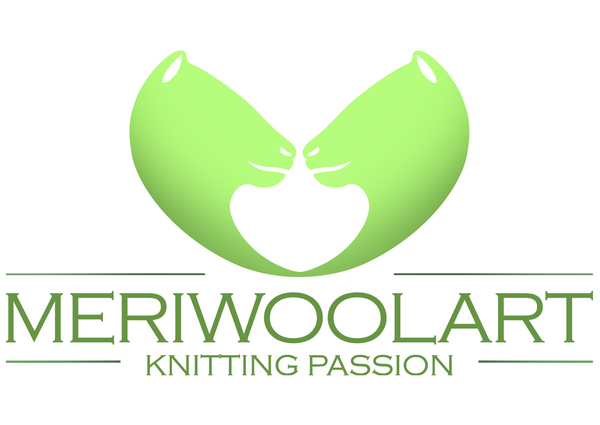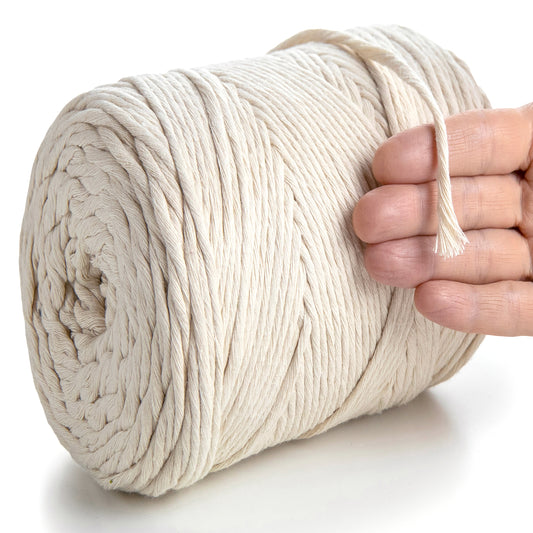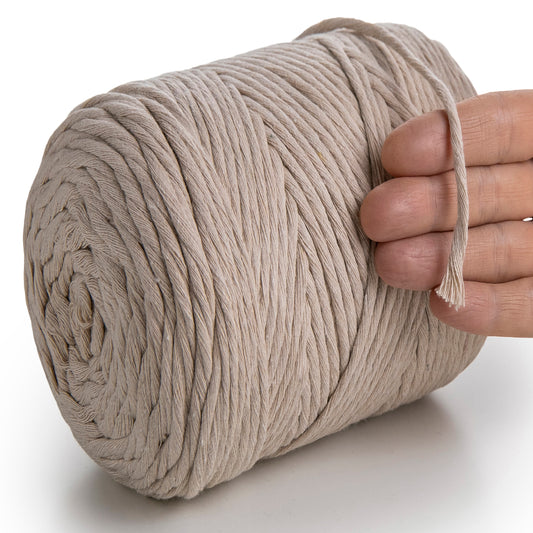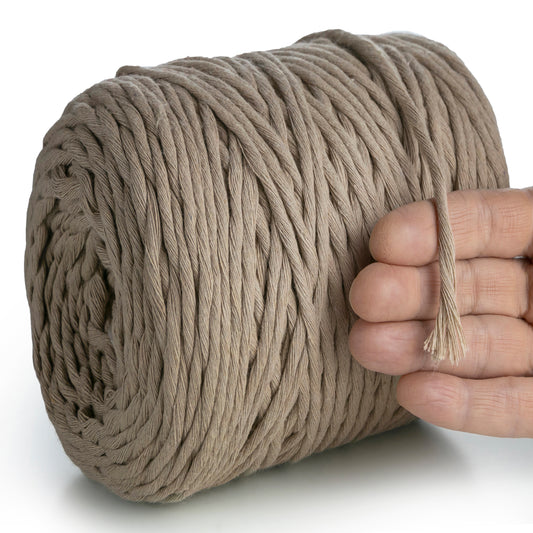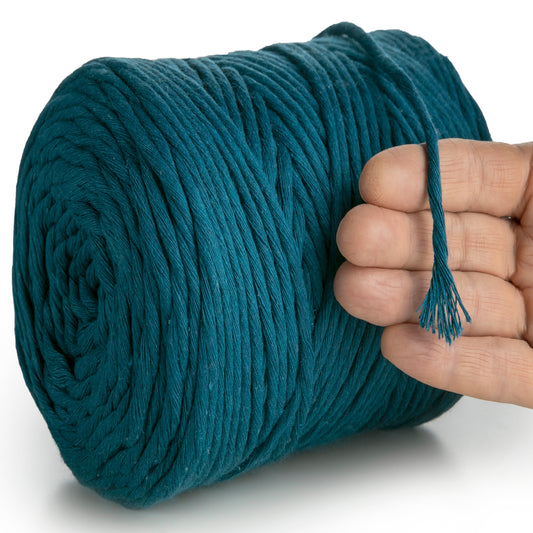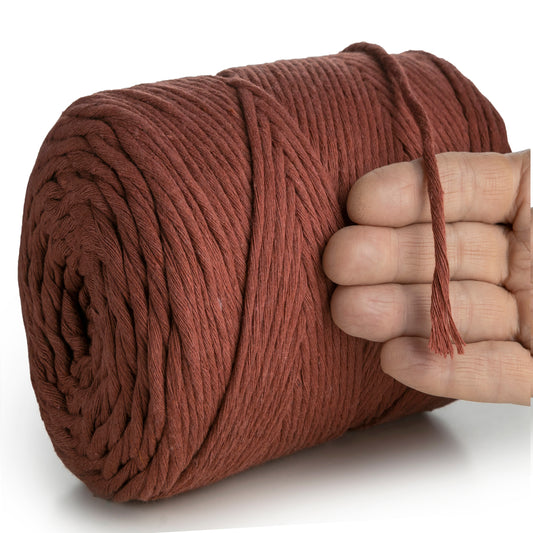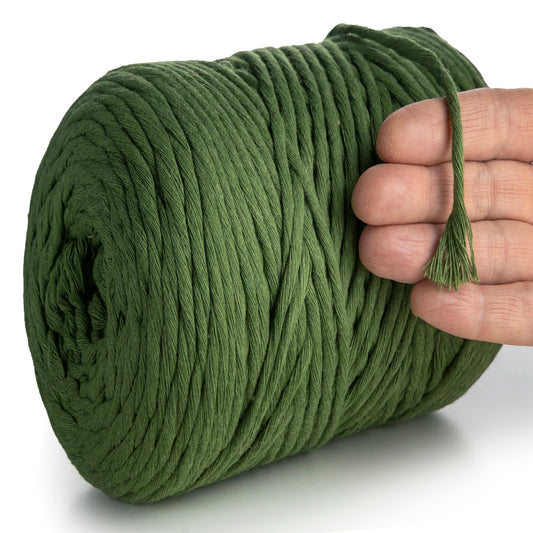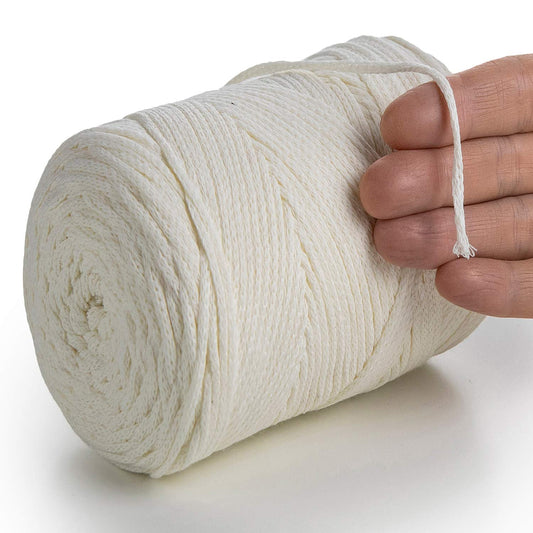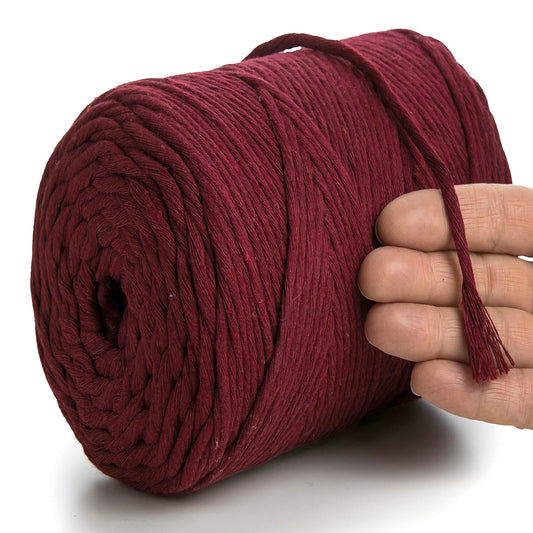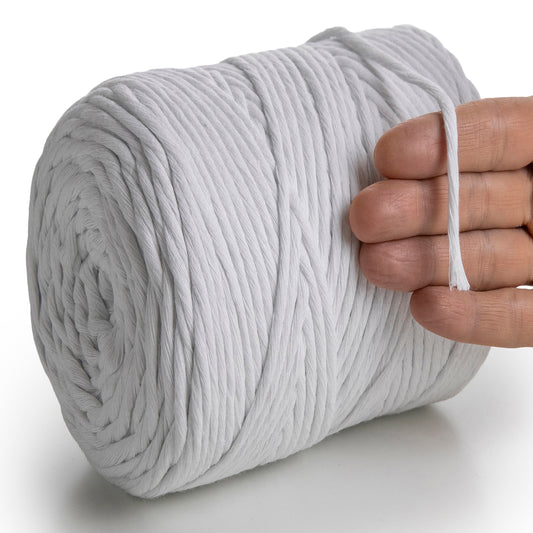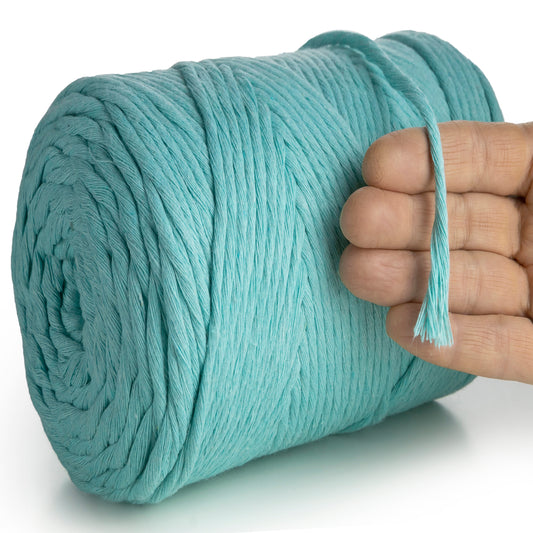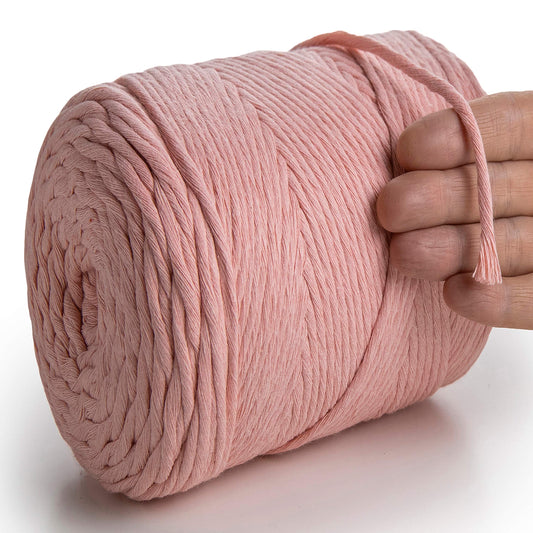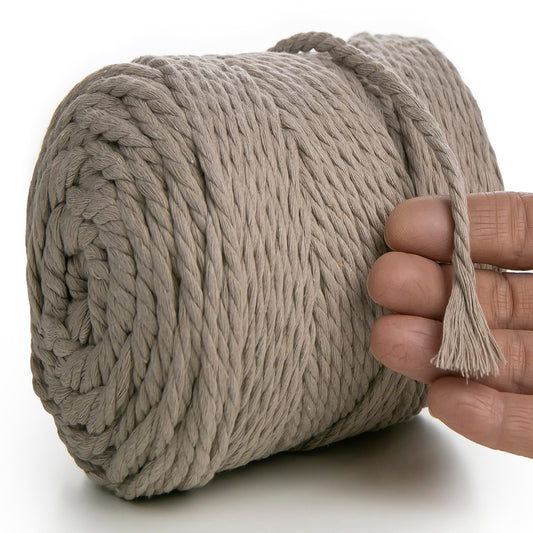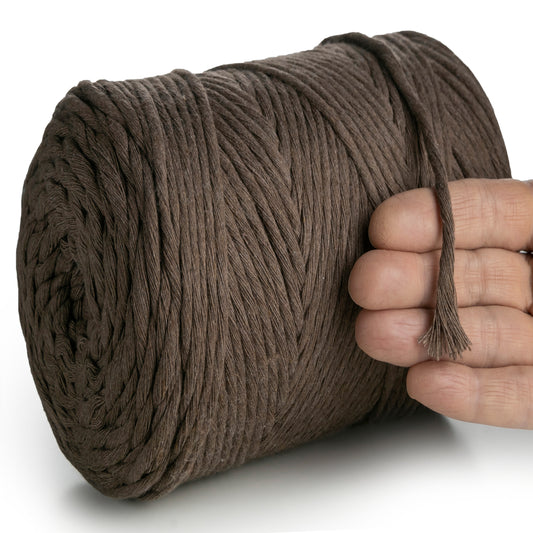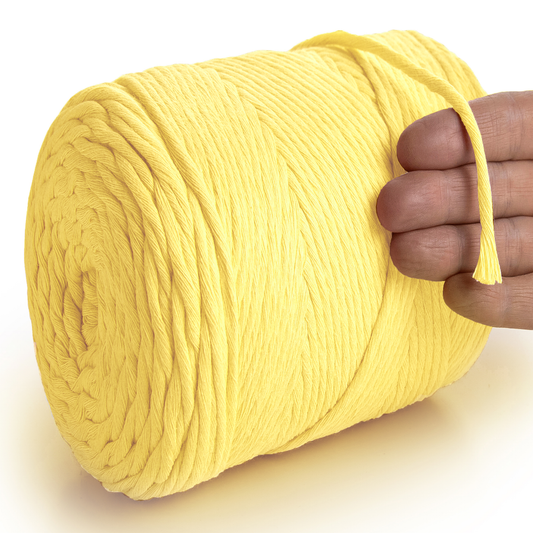Collection: Macrame Ropes
If you are looking to get your crafty hands on some top-quality cordage then you are in luck. Here at MeriWoolArt we stock a large variety of OEKO-TEX certified macramé cords perfect for any project.
Whether you are a beginner who is just learning the ropes or a professional selling their wares we are a great source for the materials you need.
If you are totally new to the world of macramé then you will undoubtedly have a lot of questions about macramé cord. It can be tricky to navigate an online market with so many sellers.
As macramé crafters ourselves we know that the end results of your project, no matter how ambitious or creative, rely heavily on the tools you have to hand. So we have done our best to answer all of your questions and steer you towards buying the right resources for your next craft project.
Read on to find out exactly what makes our macramé cord right for you.
-
Natural Single Twisted Macramé 4mm 225m
Regular price €12,97Regular price FromUnit price / per€14,97Sale price €12,97- 13%Sold out -
Sand Single Twisted Macramé 4mm 225m
Regular price €12,97Regular price FromUnit price / per€14,97Sale price €12,97- 13%Sale -
NATURAL MACRAMÉ ROPE 6 MM, 100 M
Regular price €12,97Regular price FromUnit price / per€14,97Sale price €12,97- 13%Sold out -
Dark Sand Single Twisted Macramé 4mm 225m
Regular price €12,97Regular price FromUnit price / per€14,97Sale price €12,97- 13%Sold out -
Sea Single Twisted Macramé 4mm 225m
Regular price €12,97Regular price FromUnit price / per€14,97Sale price €12,97- 13%Sale -
Terra Single Twisted Macramé 4mm 225m
Regular price €12,97Regular price FromUnit price / per€14,97Sale price €12,97- 13%Sale -
Salbei Single Twisted Macramé 4mm 225m
Regular price €12,97Regular price FromUnit price / per€14,97Sale price €12,97- 13%Sale -
Natural Macramé Cotton 2mm 250m
Regular price €7,97Regular price FromUnit price / per€8,97Sale price €7,97- 11%Sale -
Burgundy Single Twisted Macramé 4mm 225m
Regular price €12,97Regular price FromUnit price / per€14,97Sale price €12,97- 13%Sale -
White Single Twisted Macramé 4mm 225m
Regular price €12,97Regular price FromUnit price / per€14,97Sale price €12,97- 13%Sale -
Red Single Twisted Macramé 4mm 225m
Regular price €12,97Regular price FromUnit price / per€14,97Sale price €12,97- 13%Sale -
Aqua Single Twisted Macramé 4mm 225m
Regular price €12,97Regular price FromUnit price / per€14,97Sale price €12,97- 13%Sale -
Light Pink Single Twisted Macramé 4mm 225m
Regular price €12,97Regular price FromUnit price / per€14,97Sale price €12,97- 13%Sale -
DARK SAND MACRAMÉ ROPE 6 MM, 100 M
Regular price €12,97Regular price FromUnit price / per€14,97Sale price €12,97- 13%Sold out -
Brown Single Twisted Macramé 4mm 225m
Regular price €12,97Regular price FromUnit price / per€14,97Sale price €12,97- 13%Sale -
Yellow Single Twisted Macramé 4mm 225m
Regular price €12,97Regular price FromUnit price / per€14,97Sale price €12,97- 13%Sale
What is Macrame Cord?
Macrame cord, sometimes referred to as macrame rope, yarn, or string, is a cord of multiple fiber strands that are twisted or braided together. The cord is then used to tie and knot into a piece of macramé, a popular form of textile craft. The amount of strands used as well as the technique to twist or braid them varies, providing different types of macramé cords which we will discuss a little more below.
Different Types of Macrame Cords
Although the differences aren’t huge, different macramé cords are better suited to certain projects or particular techniques. If you are going to be tieing something more intricate then it stands to reason you will want something with a lot more flexibility in its material.
So let’s talk a little about how some are made, what they are best for, and why. If you are a beginner you have probably found yourself lost with some of the terms for types of cords up until now. Hopefully, we can shed a little light!
Braided cords
Braided cords are most widely sold in typical craft stores as well as big-box retailers. Because it is so easy to get ahold of many beginners who are desperate to get stuck into learning a few knots will often pop out and purchase it for its convenience.
Braided cord is actually your average rope or string and the braiding technique gives it plenty of strength to tie or secure something. Yet, most beginners starting out with macramé eventually learn the hard way that it isn’t exactly the best.
When you are learning how to tie macramé knots you will inevitably make mistakes in the early days. Trying to untie a braided cord can be very difficult because it is manufactured to stay strongly knotted.
It is also usually made from a composite of materials to give it extra strength, most of them man-made such as nylon, polyester, or polypropylene.
Even if you learn to knot your cords without any errors you will probably want to look at natural fiber cords instead.
After you have a few simple macrame projects under your belt you will soon find it doesn’t work very well for some techniques such as fringing.
Bottom line, a braided cord is fine for beginners starting out who don’t want their hobby to be too expensive. But if you are looking to progress with your skills, make meaningful gifts, or branch into selling your creations you will likely need a 3-ply or single-strand cord.
3-Ply macrame cord
A 3-Ply macrame cord is, as the name suggests, a type of cord that consists of 3 strands. For this reason, it is sometimes called a 3-strand cord instead. It can be unwound to create some interesting macramé effects. You can also get 4-ply versions which throw an extra thread into the mix. The number of strands twisted together can be important for certain techniques such as adding beading within the cord as opposed to over the cord.
Multiply cord
Multiply cord is the term given to anything with more than 3 strands held together. This can be 4, 5, or 6-strands spun together. Our Bochiknot macrame cord is available as both a 3ply or 4ply, with 4 strands twisted together to form a single strand of rope. You can get the multi-ply cord in a variety of sizes depending on the task you want to use it for 3mm, 4mm, or 5mm, is good for a variety of projects, and 6mm or 7mm would be recommendable for heavy-duty crafts that need to support weight such as toy hammocks or plant hangers.
Single strand cord
Single strand cord is considered the best for macramé because it is suitable for a wide variety of uses. It retains enough tensile strength to keep it durable but is much easier to untie and cut and can be easily combed out if you want to create a fringe.
It is, however, also one of the most expensive options out there. This is why many hobbyists tend to source cheaper cotton alternatives instead of splurging, to begin with.
Single strand cotton cord is far more comfortable on the hands, meaning you can macramé for longer periods of time.
Our single strand cord is made with a cotton and viscose blend that gives it better flexibility and softness. Our single-strand cotton macrame cord is available in 3mm, 4mm, 5mm, 6mm, and 7mm thicknesses.
Type 5
Which is best for what?
Now that you have an understanding of the 3 different types of macrame cord, let’s discuss 4 key points on what you should look for when deciding what macrame cord to use on your macrame projects.
The Best Macrame Cord for Beginners
As you will likely be undoing your work from time to time a medium rope with a thickness of 4mm-6mm would probably suit you best. They are the most commonly used size, much more sturdy than smaller ropes, and surprisingly durable when knotted together for macramé. You can get started with a myriad of home decors such as plant hangers, wall hangings, curtains, and rugs.
Where To Buy Macrame Cords And Ropes?
It is always important to source the best supplies for your craft. As we mentioned better quality cords and ropes tend to be a little pricier but there is a good reason. For a beginner hobbyist regular store-bought string will suffice but it will only take you so far.
To develop your skill and achieve great end results you need to source the best cord for the job.
There is a range of specialist stockists. But here at MeriWoolArt we feel we go the extra mile. As macramé fans, we know what we prefer to work with.
We steer clear from low-quality materials for manufacture and all of our cords meet OEKO-TEX certification standards. This means that nothing harmful is used in the process, from the threads themselves to the dyes used and spools they are spun on.
We are conscious about product sustainability and 85% of the cotton we use is therefore recycled. We use a 15% viscose blend that gives it its signature smoothness in your hands. As a result, it is easier to work with and better for clothing projects as it is much much softer.
Buying via MeriWoolArt is a super easy process, and guarantees you get high-quality. Simply sign up with an account and purchase your cord in a matter of minutes. We have a huge variety of types, colors and sizes to browse.
Once you have purchased with us your previous orders will be available for repeat future purchases as well. So if you are serious about macramé why not create an account today?
FAQ
-
What is the best cord for macrame?
If you want to take your macrame knotting techniques to the next level or create projects that truly shine then you should source some high-quality 3mm-4mm single strand cotton cord. Its softer feel really does make all the difference when you are crafting by hand and it provides great stability too. Our single strand cord is made with over 40 individual soft fibers that make fringing work effortless and beautiful.
-
What is the difference between a macrame cord and rope?
In modern times the words have become interchangeable although technically speaking there are differences. If you want to know more why not head on over to our MeriWoolArt blog article and find out all the facts for yourself.
-
How thick should the macrame cord be?
The desired thickness is dependent on the project. For Jewellery we recommend 1-2mm to be able to weave through small beads or buttonholes.
-
What is the best macrame cord for wall hangings?
4mm-7mm is an ideal size for macramé, much sturdier, and provides the strength for plant hangers, wall hangings, curtains, and rugs, etc.
-
How do I get a macrame cord?
As we already mentioned above there are a range of places you can get your hands on craft supplies but if you are serious about your macramé craft we advise always going with a specialist supplier to ensure quality.
At MeriWoolArt we only stock cords we would use ourselves. All of our products are safe OEKO-TEX certified and it is 85% recycled too so you are doing your bit for the planet.
You can feel reassured in this when you shop with us, an account takes moments to make, and then you are good to go.
-
Is macrame an expensive hobby?
The overall cost of a macrame project depends on its size. A bigger project will obviously require more cord to make. The quality of the cord also plays a part. But making macramé is often much cheaper than buying the finished product.
-
Can I use cotton yarn for macrame?
Cotton yarn for macrame is just another name for macrame cord as well as cotton yarns; you can also find wool, twine, hemp, and leather-made spools.
-
Can I use regular yarn for macrame?
Although macramé is typically made with rope, string, or cord, yarn is absolutely suitable. More often than not it is made from wool and is not the strongest for knotting but as we stated above you can find a yarn with other fibers.
-
What mm cord size do I need for my Macrame project?
3mm-5mm is the most frequently purchased for the majority of projects. This is unless, as we already said, you are looking to make jewelry, in which case the smaller the better. 3mm or 4mm is the most commonly used size. It is fine for plant hangers and wall hangings but depending on how you want it to look aesthetically you might consider a larger macrame cord especially if it is to be a big macrame piece.
